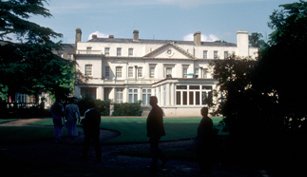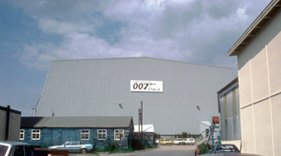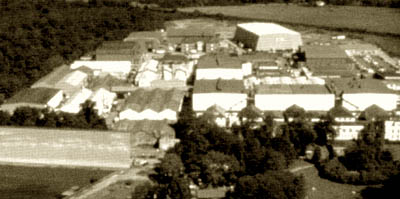In 1934, Charles Boot, a building contractor, acquired
an estate grounds and mansion called Heatherden Hall at an auction. It was a magnificent 156 acre estate near Iver Heath
in Buckinghamshire, 25 miles west of London. Boot approached J.
Arthur Rank about turning the estate into a film studio. British
National Films, Rank's new film company, purchased the property and
Boot had it remodeled. The studio opened for production September 30, 1936
with the mansion used to house all of the administrative offices.
Hall at an auction. It was a magnificent 156 acre estate near Iver Heath
in Buckinghamshire, 25 miles west of London. Boot approached J.
Arthur Rank about turning the estate into a film studio. British
National Films, Rank's new film company, purchased the property and
Boot had it remodeled. The studio opened for production September 30, 1936
with the mansion used to house all of the administrative offices.
The first film completed at Pinewood was London
Melody, which was started at British
and Dominions, but their studio had burned down in mid production. After
completing the film, Herbert
Wilcox, owner of British and Dominions, used his insurance money to
invest and become part owner of Pinewood, giving Rank a lot more production
expertise on the board.
The first film totally produced at Pinewood was Talk
of the Devil in 1937. Even though the industry was in a slump, Pinewood
kept a strong production schedule until the government requisitioned it
for war purposes. The government used Pinewood for everything from storage
to offices. The Royal Mint and Lloyds of London used the sound stages as
offices during the war. The Army Film and Photographic Unit, Crown Film
Unit, RAF Film Unit and even the Polish Air Force Film Unit were based there.
The Crown Film Unit produced numerous wartime documentaries there.
Pinewood's film production was moved to Denham Studios,
which Rank had bought from Alex Korda in 1938.
In 1946, Pinewood was reopened and production started
again.
By 1949, Rank was in debt over £16,000,000 and
knew that he had to reorganize his holdings. John Davis, Rank's accountant
and primary confidant, was told to slash budgets. Most of the studios were
closed and Pinewood became the primary focus of film production. Davis's
cuts proved extremely efficient and Pinewood began producing
a stream of quality films.
The 1950s brought more successful productions including
the start of the famous Carry
On series. The 1960s started with a buzz, with Cleopatra, the largest
production ever made scheduled to be made at Pinewood. With massive sets
made, Elizabeth Taylor had to be rushed to the hospital for a tracheotomy.
Her illness delayed the shooting schedule and bad weather set in, so the
entire production was moved to Italy. To try to utilize some of the sets,
Carry On Cleo was made. 20th Century was NOT happy and sued over the production
and the posters.
The 1960s also brought a new series that would become
a showcase of Pinewood and British technical  expertise.
It was ..... Bond....... James Bond. From Ipcress File to Charlie Chaplin's
Countess From Hong Kong, Pinewood shined.. producing over 150 feature films
in the 1960s.
expertise.
It was ..... Bond....... James Bond. From Ipcress File to Charlie Chaplin's
Countess From Hong Kong, Pinewood shined.. producing over 150 feature films
in the 1960s.
As the 1970s rolled in, the successes of Pinewood
seemed to be bringing larger and larger productions. In 1976, Pinewood needed
a superwarehouse to be used as the interior of the Liparus supertanker in
the James Bond film The Spy Who Loved Me. They decided instead
to build the world's largest sound stage that could be reused and leased
out to other studios, and named it the 007 stage. In addition, 5 other stages
were built to accomidate additional independent and television production.
The stages are given letters of the alphabet, so the stages added were H,
J, K, L, and M. Shown above is the 007 Stage. Pinewood produced over 120
films in the 1970s including blockbusters like Superman.

This is an aerial shot.. notice the 007 stage in the back
The 1980s brought a change in direction for the studio.
Pinewood had worked on the formula that 20 films a year made kept the studio
making money.... however... 2 of the new blockbusters, produced about the
same amount of profit as 20 regular films. So Pinewood started focusing
on larger productions. The 1980s brought such blockbusters as Aliens, Batman,
Living Daylights, View to a Kill and Superman sequels. In
addition, Pinewood added facilities to handle more commercials and videos.
The 1990s continued with a strong production schedule.
The studio added the largest outdoor water tank for filming in Europe.
In 2000, Pinewood was purchased by a management team
jointly led by Michael Grade and Ivan Dunleavy and backed by 3i. In June
2000, Pinewood commenced conversion of J and K film stages into two high
tech, dedicated television studios. Pinewood Studios then purchased Shepperton
Studios in February 2001 and they are now managed as one operation.
In April 2005 Pinewood Shepperton acquired Teddington
Studios. As well as the former studios of Thames Televison
Pinewood currently sits on 90 acres with 17 stages,
700 rooms, and 50 acres of sculptured gardens.
Here's their website: http://www.pinewoodshepperton.com/
Back to British Studios



